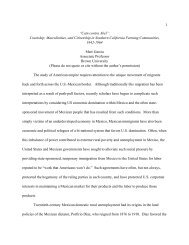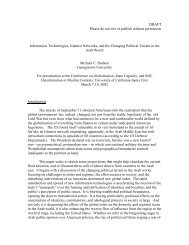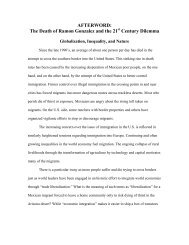An agro-ecological assessment of grower practices in California
An agro-ecological assessment of grower practices in California
An agro-ecological assessment of grower practices in California
Create successful ePaper yourself
Turn your PDF publications into a flip-book with our unique Google optimized e-Paper software.
258 JULIE GUTHMANdef<strong>in</strong>e them, layered with the more recent history <strong>of</strong>organic’s genesis. The purpose <strong>of</strong> this paper, however,is to address a specific empirical issue, which is theextent to which <strong>California</strong> organic farmers practice thetechniques <strong>of</strong> <strong>agro</strong>-ecology, organic farm<strong>in</strong>g’s mostcentral and widely accepted claim. 2 While this topicclearly l<strong>in</strong>ks to a broader set <strong>of</strong> arguments, by narrow<strong>in</strong>git so, it allows a focus on much-needed empiricalevidence that has been heret<strong>of</strong>ore only presumed.Therefore, the central theme <strong>of</strong> this paper is adescription <strong>of</strong> <strong>grower</strong> <strong>practices</strong>. These descriptions arebased on <strong>in</strong>terviews and site observations with 150 <strong>of</strong>the 2,204 organic <strong>grower</strong>s that were registered withthe state <strong>of</strong> <strong>California</strong> <strong>in</strong> 1997, both certified and noncertified.3 Interviews were conducted between December<strong>of</strong> 1997 and March <strong>of</strong> 1999. Because the medianfarm size <strong>of</strong> organic operations is quite small – 4.4acres <strong>in</strong> 1994–1995 (Klonsky and Tourte, 1998), theresearch sample was stratified to capture a statisticallysignificant group <strong>of</strong> large <strong>grower</strong>s as well as those withmixed conventional and organic operations. In otherwords, it was deliberately skewed <strong>in</strong> order to see iftaxonomic patterns exist <strong>in</strong> how organic agriculture ispracticed. So while not proportionately representative<strong>of</strong> the <strong>California</strong> organic sector <strong>in</strong> <strong>grower</strong> numbers, thestudy easily captures most <strong>of</strong> the sales and acreage <strong>in</strong>the sector.The paper proceeds <strong>in</strong> the follow<strong>in</strong>g way: First,it looks at the claims <strong>of</strong> <strong>ecological</strong> farm<strong>in</strong>g, derivedfrom <strong>agro</strong>-ecology but which have been further codifiedby <strong>California</strong> Certified Organic Farmers (CCOF) 4and briefly discusses how these pr<strong>in</strong>ciples were usedas the basis <strong>of</strong> an <strong>agro</strong>-<strong>ecological</strong> <strong>assessment</strong> with<strong>in</strong>the study. Next, it <strong>in</strong>troduces the results <strong>of</strong> this <strong>assessment</strong>,which <strong>in</strong>dicates the degree to which <strong>California</strong>farmers practice <strong>agro</strong>-ecology, both <strong>in</strong> the aggregateand with<strong>in</strong> broad taxonomies. Then, it turns to adetailed description <strong>of</strong> how organic farm<strong>in</strong>g is practiced<strong>in</strong> <strong>California</strong>, referr<strong>in</strong>g to each <strong>of</strong> the pr<strong>in</strong>cipleson which the <strong>assessment</strong> was based, both to note thepatterns <strong>in</strong> how specific <strong>agro</strong>-<strong>ecological</strong> pr<strong>in</strong>ciples arefollowed and to note differentiation by factors otherthan scale-based taxonomies. It concludes by suggest<strong>in</strong>gsome <strong>of</strong> the ways <strong>in</strong> which the very act <strong>of</strong>codify<strong>in</strong>g <strong>agro</strong>-<strong>ecological</strong> pr<strong>in</strong>ciples affects how theyare practiced.Def<strong>in</strong><strong>in</strong>g the <strong>agro</strong>-<strong>ecological</strong> criteriaAs a general rule, susta<strong>in</strong>able agricultural systems aresupposed to m<strong>in</strong>imize energy and resource use, byrecycl<strong>in</strong>g resources with<strong>in</strong> the farm<strong>in</strong>g system, or atleast by us<strong>in</strong>g resources found near the farm. Froma technical viewpo<strong>in</strong>t, the basic components <strong>of</strong> sucha system are (1) use <strong>of</strong> cover crops, mulches, andno-till <strong>practices</strong> as effective soil and water-conserv<strong>in</strong>gmeasures; (2) promotion <strong>of</strong> soil biotic activity throughthe regular addition <strong>of</strong> organic matter such as manureand compost; (3) use <strong>of</strong> crop rotations, crop/livestockmixed systems, <strong>agro</strong>-forestry, and legume-based <strong>in</strong>tercropp<strong>in</strong>gfor nutrient recycl<strong>in</strong>g; and (4) encouragement<strong>of</strong> biological pest control agents through biodiversitymanipulations and <strong>in</strong>troduction and/or conservation <strong>of</strong>natural enemies (Altieri, 1995: 92).In this study, <strong>grower</strong>s were assessed on the degree<strong>of</strong> their adoption <strong>of</strong> the above sorts <strong>of</strong> <strong>practices</strong> (onorganic fields only), accord<strong>in</strong>g to criteria developedboth to discern taxonomic difference and to determ<strong>in</strong>ehow regulation itself affects organic <strong>practices</strong>. Most<strong>of</strong> the <strong>assessment</strong> was based on comprehensive <strong>in</strong>terviewswith each <strong>grower</strong> studied, and thus captured<strong>practices</strong> as <strong>grower</strong>s themselves describe them. These<strong>assessment</strong>s, however, were <strong>of</strong>ten supplemented by thevisual cues <strong>of</strong> on-site observations, which <strong>in</strong> no casecontradicted descriptions as given by <strong>grower</strong>s, but onlyenriched them.The criteria on which <strong>grower</strong>s were assessed<strong>in</strong>clude• degree and extent <strong>of</strong> on-farm fertility managementthrough compost<strong>in</strong>g and cover cropp<strong>in</strong>g;• degree <strong>of</strong> on-farm biological pest management;• avoidance <strong>of</strong> legally restricted or controversialmaterials (expla<strong>in</strong>ed below);• employment <strong>of</strong> <strong>in</strong>novative weed control <strong>practices</strong>such as mulch<strong>in</strong>g;• bio-diversified cropp<strong>in</strong>g patterns, <strong>in</strong>clud<strong>in</strong>g <strong>in</strong>tercropp<strong>in</strong>gand <strong>in</strong>tegrated livestock; and• evidence <strong>of</strong> <strong>in</strong>tensive management (as opposed to“organic by neglect”). 5Growers were given one po<strong>in</strong>t for each criterionsubstantially met, except for the first two criteria,which were given double weight s<strong>in</strong>ce there is a muchwider spectrum <strong>in</strong> these areas. This allowed <strong>grower</strong>sto earn a middle rat<strong>in</strong>g for these two criteria. Forexample, a <strong>grower</strong> who cover crops a portion <strong>of</strong> thefarm every year and purchases compost from a supplierwould earn one po<strong>in</strong>t, one less than a <strong>grower</strong> whoprovides all the farm’s fertility needs through on farmrecycl<strong>in</strong>g and cover crops, but one more than a <strong>grower</strong>who purchases all fertility needs. Po<strong>in</strong>ts were addedand then calibrated to a one through five aggregate rat<strong>in</strong>g,one be<strong>in</strong>g assigned to <strong>grower</strong>s who took none <strong>of</strong>these affirmative steps, and five go<strong>in</strong>g to those who didall. In addition, a rat<strong>in</strong>g <strong>of</strong> zero was assigned to <strong>grower</strong>sif they were <strong>in</strong> obvious violation <strong>of</strong> organic codesand <strong>practices</strong>. When round<strong>in</strong>g was required, additionalfactors were considered, such as attention to water conservationor on-farm seed and transplant development,





